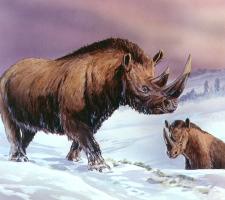A woolly rhinoceros skeleton unearthed at a
When it was discovered at the Whitemoor Hay sand and gravel quarry near Alrewas, County Staffordshire, England, the remains were billed as “the most significant fossil find of a large mammal in Britain for over 100 years”.
Now, following years of research, the exceptionally well-preserved bones are offering up the secrets of climate in Britain 42,000 years ago.
A team of scientists from the UK and the Netherlands, led by Professor Danielle Schreve from Royal Holloway, University of London, analysed the skeleton alongside the remains of other animals such as mammoths and reindeer and well-preserved insects to create a picture of our Ice Age environment.
A team of scientists from the UK and the Netherlands, led by Professor Danielle Schreve from Royal Holloway, University of London, analysed the skeleton alongside the remains of other animals such as mammoths and reindeer and well-preserved insects to create a picture of our Ice Age environment.
They found that summer temperatures in Britain would have averaged just 10ºC and dropped to -22ºC in winter. Results are published in the Journal of Quaternary Science.
Ross Halley, head of mineral resources for Lafarge Tarmac, said: “It is quite astounding to think that bones found at one of our sites have been so critical to understanding how our ancient weather worked.
“When we unearthed the skeleton in 2002, we knew we had come across something special, and now we are beginning to see just how important this find is.









